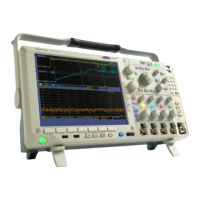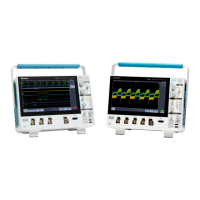Commands Listed in Alphabetical Order
MATH[1]:TYPe
This command specifies the math type (DUAL, FFT, ADVanced or
SPECTRUM
). This command is used along with MATH[1]:DEFine, which specifies
the current mathematical expression as a text string which defines the waveform.
You must specify the math type before defining the math expression. For a listof
math expres
sions, see MATH[1]:DEFine.
Group
Math
Syntax
MATH[1]:TYPe {DUAL|FFT|ADVanced|SPECTRUM}
MATH[1]:TYPe?
Arguments
DUAL sets the type to dual waveform math, which can use any combination of live
analog or reference waveforms in the time domain display.
FFT sets the type to FFT math, which can use any live analog or reference
waveform in the time domain.
NOTE. You can also use FFT as part of a math expression by declaring the type
ADVanced.
See examples for the command MATH[1]:DEFine.
ADVanced sets the type to advanced math.
SPECTRUM sets the type to spectrum, which can use any combination of live
RF or reference traces in the frequency domain. (MDO3000, MDO4000/B, or
MDO4000C models with option SA3 or SA6 only.)
Examples
MATH:TYPE FFT sets the math type to FFT.
MATH:TYPE FFT;:MATH:DEFI
NE “FFT( CH1 )”;:SELECT:MATH1
sets the
math type to
FFT and displays an FFT waveform of the channel 1 waveform,
using the current FFT scale and window settings.
MATH:TYPE ADVANCED;:MATH:DEFINE
“INTG(REF1*CH3)+DELAY(CH1,CH2)”;:SELEC T:MATH1
sets the math type to
ADVanced anddisplaysanadvancedmathwaveformthatistheINTEGRAL
of the product of REF1 and CH3 plus the result of the delay measurement
between channel 1 and 2.
MATH[1]:VERTical:POSition
This command specifies the vertical position of the currently selected math type.
MDO4000/B/C, MSO/DPO4000B and MDO3000 Series Oscilloscopes Programmer Manual 2-417
